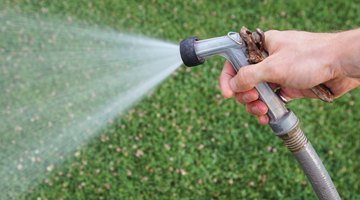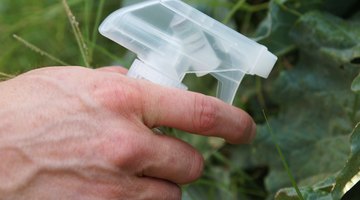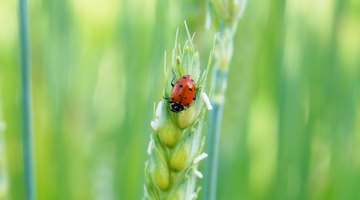How to Naturally Kill Bugs on Kale
Kale, a common garden vegetable related to cabbage and other cole crops, is a member of the Brassica genus, with a number of species and cultivars for the garden. Kale serves as a tasty vegetable whether it's cooked or raw. But you're not the only one who likes to munch on kale; many bug species also love eating kale.

If insect pests have turned your kale garden bed into an all-you-can-eat salad buffet, take action. To minimize potential toxicity risks for you and your family, try all-natural or organic methods of kale bug eradication before resorting to chemical insecticides.
-
Blast your kale with strong jets of water from your garden hose. This physically removes and deters insect invasions and also helps kill certain fragile bug species, such as the soft-bodied aphid -- a common kale pest. While kale leaves are firm and hardy, limit this bug control method to just once a day to avoid causing undue damage to your kale plants.
-
Spritz your kale with soapy water. The soap film coats the bodies of any present insects and suffocates them. Once the soap dries, it also creates a bitter-tasting residue that keeps new bugs from moving in. For effective results, combine a teaspoon of liquid dish soap with half a gallon of fresh water in a spray bottle. Most dish soaps are nontoxic, but if you're worried, try using an organic and biodegradable dish soap.
-
Release ladybugs in your kale garden bed. These are especially effective for naturally killing and reducing aphid populations, which commonly infest kale and other cole crops.
-
Remove beetles and caterpillars manually. Such handpicking is a natural and effective form of pest control in smaller gardens. Drop the bugs into a bucket of soapy water to quickly kill the pests and prevent them from simply returning to your kale.
-
Spray your kale with a natural and organic insecticide if you notice heavy insect invasions -- causing wilting and other signs of visible plant distress -- on 10 percent or more of your kale plants. The manual handpicking you accomplished in the previous step can easily help you determine the level of insect invasions. Sprays tend to run off the glossy kale leaves. Remedy this by adding about 3 teaspoons of liquid soap per gallon of spray mixture to improve the liquid's adhesion. Spray both sides of the leaves with a fine mist until they are wet. Spray twice, five to seven days apart, and avoid spraying on a hot, sunny day. For effective, natural pest control against all kinds of common kale pests, including beetles and leafminers, try spinosad. Based on a soil-dwelling bacterium, the spray satisfies federal regulations concerning organic certification for vegetables.





Things You Will Need
- Water hose
- Dish soap
- Insecticidal soap (optional)
- Spray bottle
- Ladybugs
- Bucket
- Spinosad insecticide spray
Tip
Lightly dusting your kale plants with diatomaceous earth can also naturally kill any present bugs. Use a dusting tool to cover the undersides of the leaves as well as the tops with a fine layer. Learn to identify beneficial insects in all stages of growth. For instance, lady bug larvae appear as segmented, orange-and-black grub-like creatures on the plants. Protect them -- they are voracious pest-eaters. Avoid using dishwashing detergents that contain degreasers or antibacterial ingredients. These chemicals quickly break down the protective cuticle layer of the leaves, damaging or even killing the plant. Choose dishwashing soap or an insecticidal soap instead. Spray twice, about five to seven days apart, in the morning or evening; avoid spraying on a hot, sunny afternoon.
Warning
Keep your kale garden weed-free. Weeds commonly harbor and attract bug pests that then move on to your vegetables.
Overuse of soap sprays may damage the plants.
References
Writer Bio
Joshua Duvauchelle is a certified personal trainer and health journalist, relationships expert and gardening specialist. His articles and advice have appeared in dozens of magazines, including exercise workouts in Shape, relationship guides for Alive and lifestyle tips for Lifehacker. In his spare time, he enjoys yoga and urban patio gardening.
Photo Credits
- Jenna Winkeller/Demand Media
- Jenna Winkeller/Demand Media
- Jenna Winkeller/Demand Media
- Jenna Winkeller/Demand Media
- Jenna Winkeller/Demand Media
- Jenna Winkeller/Demand Media
- Jenna Winkeller/Demand Media
More Articles



